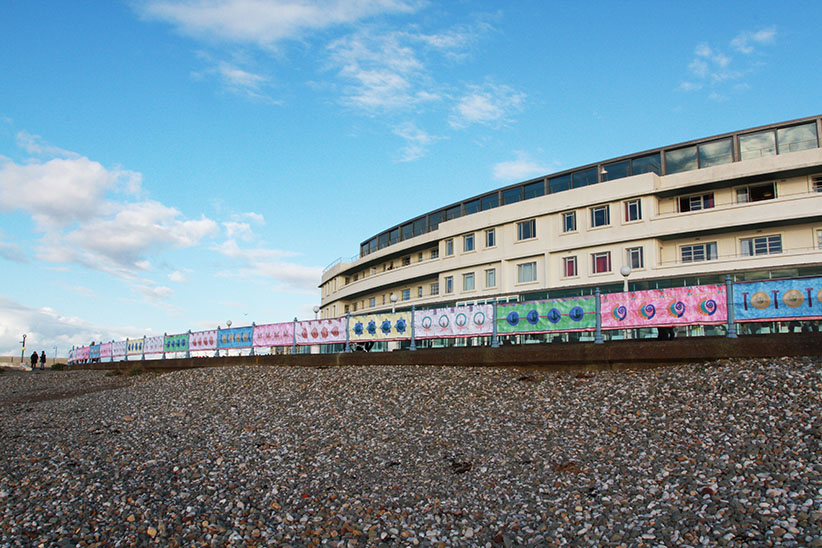

Tirazh Garwood, who painted the lost Ravilious mural alongside husband Eric Ravilious, noted that opening speeches for Oliver Hill’s opulent art deco Midland Hotel on 12 July 1933 were, “amusing in the sense that they almost openly said we don’t like this hotel ourselves, but we hope to attract Americans with it.” Jenny Steele’s exhibition This Building for Hope at the Midland unites her extensive research into Seaside Moderne architecture in North West England and Scotland with recent research into Miami South Beach architecture; an area of over 800 art deco buildings across one square mile.
Steele probes this rich context through installing new print, sculpture and architectural interventions across the hotel. The Midland is a classic example of the Seaside Moderne style, complete with curving forms and nautical features (‘a big white concrete ship’, according to Garwood), and architecturally prominent due to its holistic approach to design. Hill commissioned Eric Gill to carve significant works within the lobby and the attention to detail – from curved door handles to precisely coloured furnishings – is immaculate; Hill obviously had observed Frank Pick’s workin London.
Many of Steele’s sculptures and prints are situated in the hotel lobby and bar. The Fountain – North Beach (2017) is carefully positioned at the swirling heart of a Marion Dorn swirling chocolate brown, orange and cream rug. The title of the work, and its distinctive colour palette – from pastel blues to vibrant yellows – strongly references Miami South Beach architecture and its cultural mythology. Motifs play a key role in Steele’s fusing of Morecambe and Miami. Not so Nautical A Divide (2017) is comprised of 46 digital banners attached to railings outside the hotel on the seafront. Visible from the hotel, the banners combine swirling colours and architectural motifs; a joyful promenade that transports the architectural optimism of sun-drenched Miami to grey Morecambe.
To contextualise her research, Steele invited Martin Zebracki, Cultural Geographer (University of Leeds) and David Jarratt, Senior Lecturer in Tourism & Events (UCLan) to present alongside her at the Transatlantic Seaside Moderne symposium in the hotel. Drawing attention to ‘façades’, Zebracki’s research highlights tensions between dominant preservation narratives of Miami’s art deco architecture district and the queer social legacy of the area since the 1980s. Jarratt brings us back across the Atlantic with his concept of ‘seasideness’; a sense of place specific to seaside resorts and facilitated by that environment. Anchoring nostalgia as a key trait at the heart of seasideness, Jarratt reveals his qualitative research in Morecambe found the Midland to be a significant site of (positive) nostalgia for locals. An expansive follow up discussion touched on issues of class and gentrification. As the day finished with afternoon tea on the hotel sun terrace; it was hard not to reflect on Jarratt’s findings while eating cucumber sandwiches, watching the tides silently roll into Morecambe Bay.
The symposium succeeded in further teasing out the social, architectural and utopian strands within Steele’s work, alongside her talent for reinterpreting a plethora of reference points in an engaging way through her artistic prism. However, within the overwhelming splendour of the hotel, Steele’s work arguably loses some of its aesthetic resonance and autonomy in situ – the Midland becoming perhaps too much of a fitting muse. While Steele embraced the new challenge of working within a non-art space so prominent to her research, it will be interesting to see how this body of work translates within a gallery environment.
Jack Welsh
Miami To Morecambe: This Building For Hope, The Midland Hotel, Morecambe.
4 – 22 October 2017. Open all day, every day.
This review first appeared on Corridor8 on 11.10.17. You can read it here.